International context
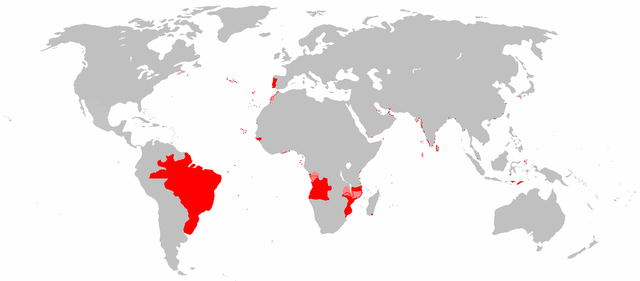
In November 1807 as Napoleon unleashed an invasion of Portugal, the Portuguese Navy transported the royal family to Brazil, led Príncipe Real, the 90 cannons flagship carrying the Prince Regent D. João and 15,000 personal and royal acquaintance. That was the largest exile of the Portuguese elites in history. In retaliation Portuguese forces in Brazil conquered French Guiana in January 1809 with an amphibious invasion by a Portuguese naval flotilla supported by a British frigate, landing 550 marines and 700 Brazilian troops. Later the Navy hunted down French trade vessels in Southeast Asian waters. Between November 1809 and February 1810, the Macau Flotilla hunted down Chinese pirates, culinating in the battle of Boca do Tigre.
In 1822 Prince Don Pedro declared the Independence of Brazil, leading to create a Brazilian Navy constituted by Portuguese ships seized here, with their crews. Small naval clashes took place afterwards with Portuguese Loyalist naval forces. But with the death of King D. João VI instability led to the Portuguese Civil War (Prince D. Pedro fought against his Brother D. Miguel, leading to a major naval battle between a fleet of about 60 ships led by British admiral George Rose Sartorius, on July 8, 1832. The fleet landed 7,500 men near Mindelo to capture Porto while the liberal army was besieged for a year. Miguelist forces cannot took the city and instead opened another front in the rear of the Liberals, landing in the Algarve. But the flotilla was ambushed by the Liberal fleet, under command of another British admiral, Charles Napier. The Miguelist fleet was then commanded by Manuel António Marreiros, and it was defeated in the Battle of Cabo de São Vicente on July 5, 1833, prompting the end of the Civil War finally on the 24th.
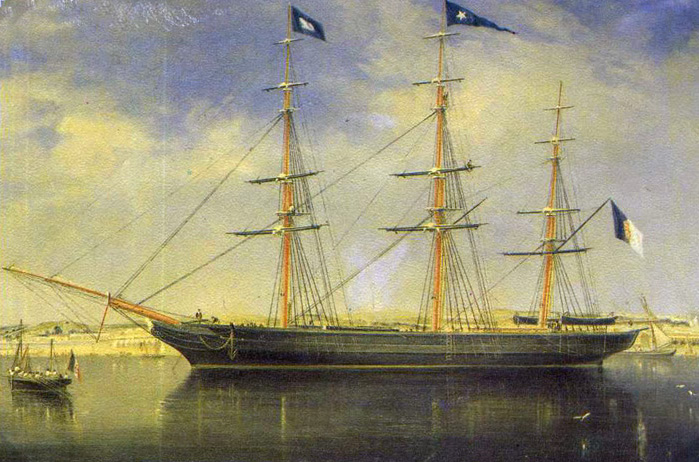
The corvette Porto (1848)
South America, independent (including Portuguese former colony, now Empire of Brazil) still left Portugal with an extensive colonial Empire (image). During the Third empire starting in 1822, Portugal turned to continental Africa rather than just emporions on the coast. This was time East Africa, West Africa, Guinea, and Timor in Asia were conquered, while from 1834 too place the Liberal Wars. Part of this new empire was to compensate the loss of Brazil and South America in general, as it only remaines a few possessions in Asia. The navy played an instrumental tole for the support of invasions in the hinterland of Angola and Mozambique, with explorers Serpa Pinto, Hermenegildo Capelo and Roberto Ivens being among the first Europeans to cross Africa west to east. Aspirations in the 1880s were ultimately unacceptable to the British, who had their own aspirations in Africa. The Ultimatum of 1890 imposed upon King Carlos I ended these Portuguese dreams of grandeur, resurrected under the rule of nationalist dicator Antonio Salazar in the interwar.
Defending and expanding the Empire 1840-1870
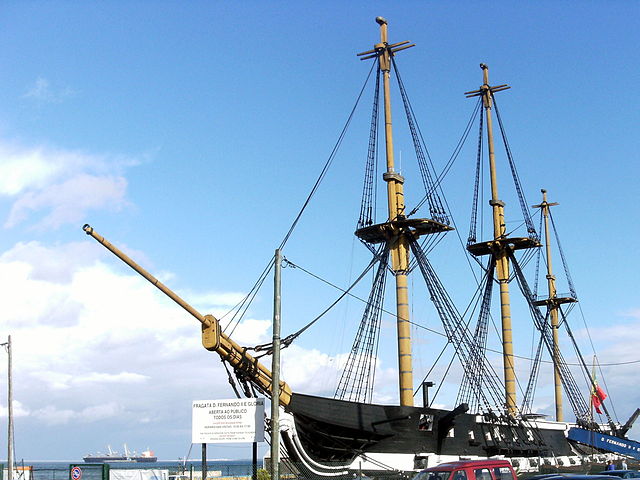
The Frigate Dom Fernando II e Gloria, the oldest schoolship in 1938, ravaged by a fire in the 1960s but restored and now on display as a museum ship in Alamada.
The Armada Portuguesa in 1890
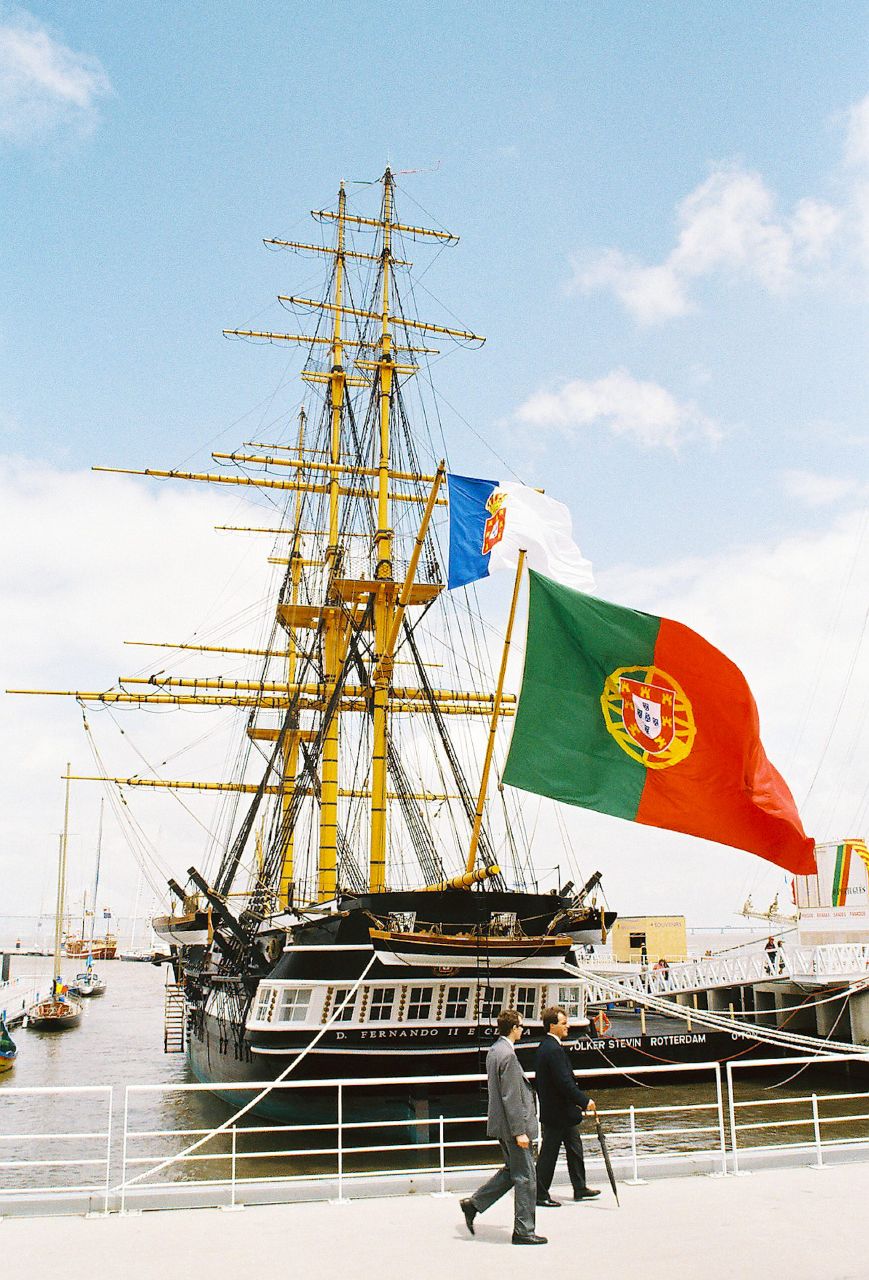
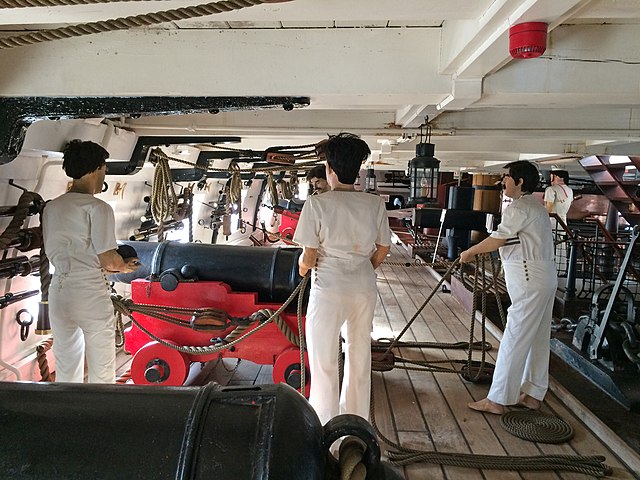
The Dom Fernando, a surviving all-sail gunnery schoolship and among the largest ships built in India in the XIXth Century.
In 1860, the Crimean War ended, but the American Civil war had not yet started. The Portuguese fleet of the time was not massive, considerably reduced after the losses of the civil war in 1833 and the ships seized by (or defecting to) the Brazilians in 1822. It was centered around A 80 (later 74) guns ship of the line, a large Frigate, three sailing corvettes, a few side-wheel steamers, a steam corvette and two steam frigates. With this, it was hoped to defend the country, but also maintain the empire, stretched between Africa and Asia and the aspirations of the always hungry British and French. The bulk of the possessions covering 800,000 square miles still in 1865 were centered in Africa, which was too underdeveloped to hope managing sufficient revenues of any kind.
The taming of these vaste lands was consuming way more budget that producing any and mismanagement back in Lisbon did not improved things. This had an immediate effect of the Navy which missed the replacement or conversion of older sailing vessels, or the Ironclads for that matter. In fact Brazil, competing with other powers of the region, was quicker to adopt the new type of ship than Portugal. Troubles at home and a grave economic crisis precluded the purchase of any more ships after the purchased of three modest, but modern 2,330 tons steam Frigates (The Bart. Dias class) launched in 1858 and the 1858, 160 tons steam Corvette Sagris.
At last, in 1862 and 1864, two steam sloops (1300-1400 tons, 180 feets long 660 ihp, 13 guns) were built in Lisbon. In 1874 it was decided to at least concentrate the remaining Portuguese fleet to the Empire and defend the capital with a detterent ship, which only could be at this time and age an Ironclad. This was the choice of voting the construction in Britain on a rather small but well protected and armed central battery vessel, as broadside ironclads were obsolete by that time. Less guns, but of a modern rifled, rear loading type, heavy type with more traverse, allowing to concentrat armor in a reduced citadel. That was Vasco Da Gama, third of the name, from Thames iron Works. She was to be permanently anchored in the Tagus. Interestingly enough, she was completely modernized in the 1880s and moreover in Italy in 1902, allowing this to soldier on for the Portuguese Navy until 1934, with more than half a century of continuous service.
Apart this, the same year she was launched, the same plan asked for a new 1100 tons steam sloop, built in the same yard, capable of 11.4 kts and well armed with 7in and 6.4 in RML guns. But for colonial service, Gunboats was the order of the Day: In 1869 up to 1877, the three Tejo class (578 tons) Lisbon built, Rio Lima (Laird Yard) in 1875 as well as Tamega and Sado the same year, Bengo, Madovi in 1879,
The 1880s
No major warship could be ordered and the Navy was left with its 1870s fleet. But for its home defence, the admiralty decided to adopt and test the brand new weapon in development since 1875, the torpedo. This was done by purchasing to Yarrow, UK, N°1, later named “Espadarte”, Portuguese very first torpedo boat. This 53 ton vessel was armed with two 14-in TTs at the bow. In 1886, the Navy ordered three more (N°2, 3, 4) to Yarrow, of an improved type of 65 tons capable of 13 knots. Rated 3th (or coastal defence) class, they complemented Vasco Da Gama on the Tagus until WWI, despite being completely obsolete.
Were built also in this decade the Gunboat Zambezi (in Lisbon) in 1880, Vouga in 1882, Liberal and Zaire in 1884 (by Laird), and Diu in 1889. All these were almost flat-bottom to be able to go far inland via major rivers in Africa. Diu was assigned to Goa, India however. A single steam sloop, Alfonso d’Albuquerque, was also ordered and built in Thames Iron Wks, launched 1884. And that was it.
Post 1890 to WWI
Pre-1914 Portugal was a troubled country emerging just from a revolution: The partition of the former Portuguese colonial empire in Africa being shared between England and Germany since the Berlin Treaty in 1878, and the alliance with England reactivated with the treaty of Windsor in 1899. The discredited the monarchy, which ended in 1908 with the assassination of Don Carlos I, followed by a violent revolution which led in 1910 to the accession to the throne of the house of Braganza, and Manuel II, with the promise of a parliamentary monarchy. But the new monarchy was soon corrupt and unpopular. The clashes were violent between Socialist Republicans and Royalists, and the Navy played its role in particular during the bombing of Lisbon. The crews were overwhelmingly in favor of the republic. The latter was proclaimed on October 5, 1910.
Meanwhile at least, the Portuguese Navy was correctly funded, and in 1895 was launched a very ambitious naval plan to replace all the 1860-1870s vessels still in service. For this, although the Vacso was still potent after her last modernization as essentially a guardship on the Tagus, the admiralty found necessary to protect their fledging colonial Empire amidst new colonial aspirations, by a fleet of cruisers: Adamastor in Orlando, Italy, The Sao Gabriel class in Le Havre, France, Dom Carlos I in Britain (Armstrong), launched respectively in 1896 and 1898, while agreements and technology transfers allowed Lisbon naval arsenal to be considerably modernized, allowing the construction of the Cruiser Rainha Dona Amelia, launched in 1899, completing this considerable force of five modern cruisers, all but one protected and armed with 5.9 in guns. They were still relatively small to international standards, between 1630 and 4000 tons, 18-22 knots. The budget being spent there still allowed the construction of a single 790 tons gunboat in Lisbon, Dom Luiz, launched 1895.
For all this time, Lisbon also hosted many great naval powers’s major warhips which were duly examined and visited by the Portuguese admiralty. Let’s cite the Italian ironclad “Italia” built in Castellamare di Stabia. But the most impressive host in 1888-89 was certainly the 12,000 tons HMS Trafalgar, completely dwarving the Vasco da Gama. In addition there was a semi-permanent British Squadron in Lisbon, ready to intervene in the mid-atlantic: The Ironclads HMS Minotaur, Northumberland, Agincourt, and Achilles. The channel fleet commande by A. Hood also made nearly yearly stops in Lisbon.
Gallery
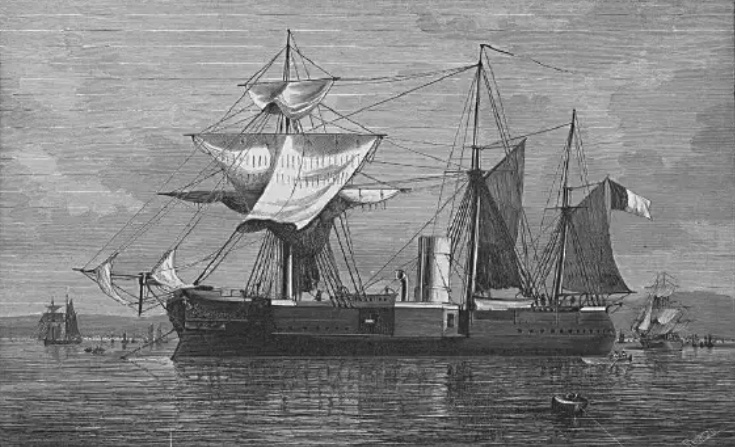
Vasco da Gama under sails
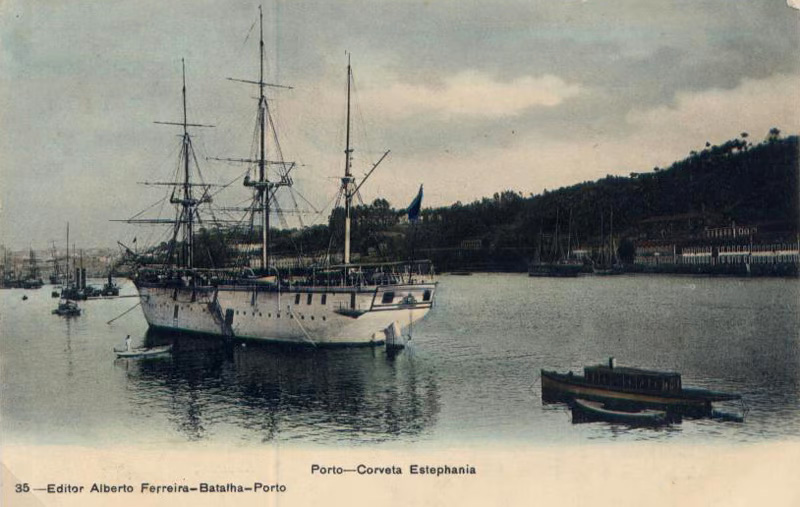
Corvette Estephania
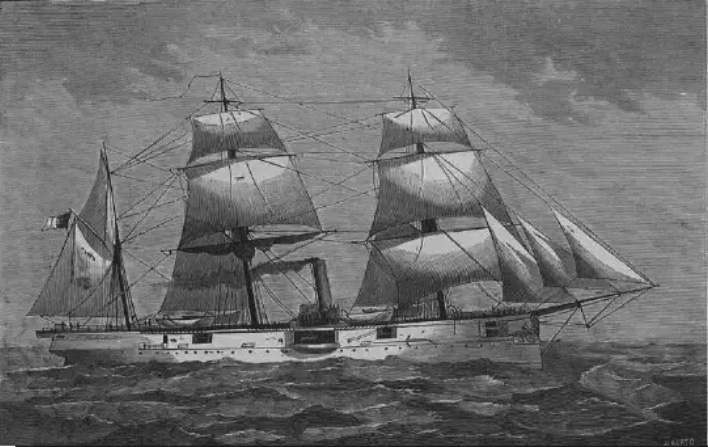
Alfonso de Albuquerque
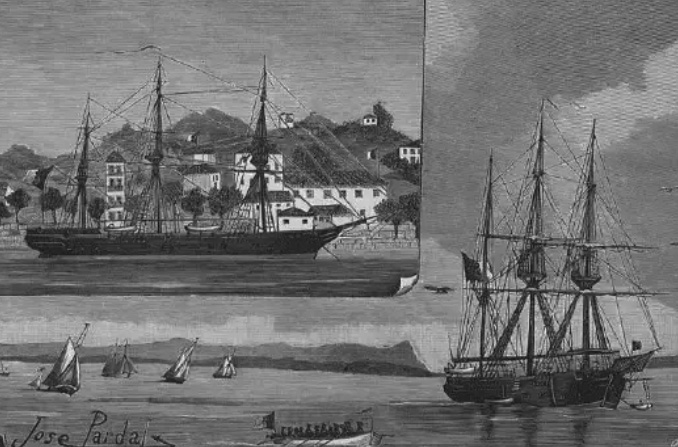
Duque da Palmela and Sagres
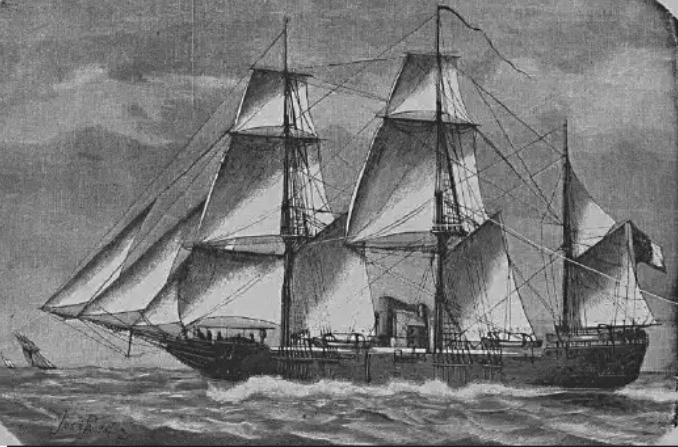
Duque da Terceira
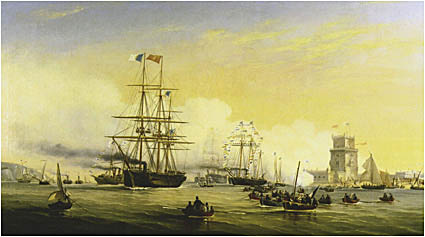
Bartolomeu Diaz

Sagres at sea
Articles to cover
![]() No longer active in 1890
No longer active in 1890
Bartolomeu Dias class (28-guns) steam frigates
Sagris (14 guns) steam corvette
Vasco Da Gama (74 guns) Ship of the Line
Dom Fernando I e Gloria (50) Sailing Frigate
Dom Joao I class (14 guns) Sailing corvettes
Portuguese Side-wheel steamers
![]() Still active in WW1
Still active in WW1
Coastal Battleship Vasco da Gama (1875)
Portuguese Torpedo Boats
Portuguese Gunboats
Read More
Boehm, H.H., Fregatte Dom Fernando II e Glória. Das Logbuch, 1998(3): 155–121.
Dotan, Y., Watercraft on World Coins: Europe, 1800-2005, 2007.
Ferraz Sacchetti, A.E., D. Fernando II e Glória: a fragata que rensceu des cinzas. Lisbon (Clube de Coleccionador dos Correios), 1998.
Leitão, M., and Oliveira Simões, F., Fragata D. Fernando II e Glória: restauro e recuperação. Lisboa (Edições Culturais da Marinha), 2002.
Paine, L.P., Warships of the world to 1900, 2000.
https://repositorio.ul.pt/bitstream/10451/1703/1/21632_ulfl071884_tm.pdf
ancient official site for Ferdinand II e Gloria archive.org
List of Marine Ministers
https://ccm.marinha.pt/pt/dfernando
academia.edu Marinha_de_Guerra_Portuguesa_1880_1900
The ‘Civilising Mission’ of Portuguese Colonialism, 1870-1930, By Miguel Bandeira Jerónimo
Topedo Boat Espadarte
On battleships-cruisers.co.uk
On forumdefesa.com/
Late Gunboats on housesofmaputo.blogspot.com
Riverine Gunboats on marinhadeguerraportuguesa.blogspot.com
Marinha do Brasil: Uma Síntese Histórica
On marinha.pt/ Revista_Armada
Late riverine gunboats, paddle wheeled.
Lisbon Maritime Museum: Detailed models
Portuguese Ships in Detail
The “Antigua Marinha”
 Ship of the Line Vasco Da Gama (1840)
Ship of the Line Vasco Da Gama (1840)
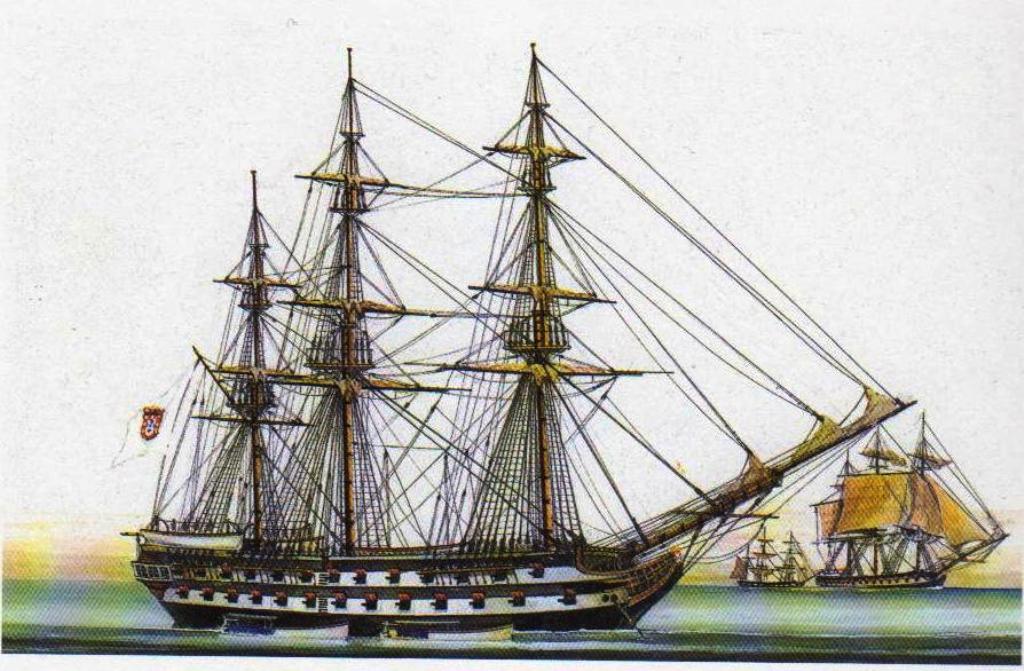
The fleet’s flagship since 1841 was also a sizeable ship of the line which was never converted to steam and served as is until 1876. She was was the last of her kind in the service with the Portuguese Navy, originally built at the Arsenal da Marinha, in Lisbon. She was classified as an “80 guns ship”. She was at first christened “Cidade de Lisboa” but it was changed quickly before launch by “Vasco da Gama”, second of the name after a 1792 vessel, and two more would be named so afterwards, in 1949 and 1989, both frigates. In 1849 she was sent in Rio de Janeiro, towed without masts to be completed with. In 1858 she transported troops in Angola. In 1870 she was versed to the reserve, sold 1876.
Specs:
Displacement: 3,200 t, armament 80 MZL in two a half batteries, crew 650.
 Ship of the Line Dom Fernando I e Gloria (1843)
Ship of the Line Dom Fernando I e Gloria (1843)

“Ferdinand” for simplification was the last pure sailing ship of the line of the Portuguese Navy. Built in Damão, Portuguese India, under the supervision of shipbuilder Gil José da Conceição, she used teak wood from Dadra and Nagar Haveli. Launched on October 22, 1843, she was towed to Goa to be outfitted. She was named after the Portuguese royal couple, King-Consort Fernando II and Queen Maria II (first name was Maria da Glória). Armed with 50 guns, with 28 in the main battery deck, 22 on the open deck, the latter comprised 20 carronades and 2 traversing guns with paixhans type grenades. Her maiden voyage was made from Goa to Lisbon in February-July 1845 2 under command of Roberto Teodorico da Costa e Silva.
She served for 33 years, covering some 100,000 miles, used to transport troops to Angola, India and Mozambique and took part in many operations in the Portuguese Colonial Empire, also supporting António Francisco da Silva Porto’s land expedition between Benguela (Angola) and the coast of Mozambique. By September 1865 she replaced Vasco da Gama as naval gunnery training ship, cruising until 1878, instructing that year Marine Guard in the Azores. Afterwards she was anchored in the Tagus but her traditional gunnery role ceased in… 1938 and she took the honorary role of flagship of the Tagus naval forces. In 1940 she became a social institution for poor’s families boys. In 1963 she was wrecked by a fire, but ultimately preserved and completely restored at the Aveiro shipyardsn unveiled as a museum ship at Expo 98 in Lisbon, on display since 2008 in Almada.
Specs: Dimensions 86.75 x 12.80 x 6.40 m, Displacement 1,850 t, Sail area 2,062 m2, Speed 8 knots, crew 270.
 Dom Joao I class Sailing corvettes
Dom Joao I class Sailing corvettes

Dom Joao I and her sister ship were built at the Damão arsenal in teak wood. Director Jadó Simog designed there fully rigged, three masted corvettes using material obtained from the demolition of the older corvette Infante Dom Miguel corvette. The lead ship was launched on 9 October 1828 and upon entering service she showed good seaworthiness and speed. She was first based in Goa, India, arriving on November 28.
In 1830 she sailed from Goa under command of Captain-Lieutenant José António Marcelino Pereira for Lisbon with the former governor of Macao aboard. The next year she was caught in the civil war, and captured by the French squadron led by of RADM Albin Roussin (battle of the Tagus) and served for a short time with the French navy, but returned to Portugal on 30 July 1834. Later she sailed under command of Captain-Lieutenant João Maria Ferreira do Amaral to Sardinia for a diplomatic mission for the new government. In 1840 (under Cap. Francisco Soares Franco) she departed Funchal for Maranhão to protecting Portuguese citizens here. She also carried the infantry batallion N°8 to the Algarve and in 1841 hunted down smugglers in the Azores. In October she sailed to Rio de Janeiro’s local naval station.
On 22 July 1847 she sailed to Madeira and the Azores to support the new civil authorities after the Gramido convention. In 1849 she was in Brazil with a plenipotentiary minister to the Imperial Court of Rio de Janeiro. In 1850 she sailed to Macao with Governor, ex-Captain Pedro Alexandrino da Cunha. In January 1851 she was in Hong Kong with governor Francisco António Gonçalves Cardoso on board. In 1852, (Capt. Domingos Roberto de Aguiar) she was part of the squadron escorting Empress Amelia Duchess of Braganza to Madeira. From Macau she dropped anchor in the Cape of Good Hope and Timor. In 1854 Dom João I transported the governor and a French minister plenipotentiary from Macao to Ning-Po and on her return, hunted down Chinese pirates.
In 1860 she carried the governor Isidoro Francisco Guimarães to Japan for a peace and trade treaty, and another one in 1861, stopping in Shanghai; 1864 she ledt the Tagus with the gunboat Maria Ana and schooner Barão de Lazarim carrying troops to Mozambique. In 1866 she was stationed in Angola, carrying the new governor general Francisco António Gonçalves Cardoso. In 1869 she was stationed in Macau, weathering a violent storm but was saved by her captain Tomás José de Sousa Soares de Andréa. In 1873 she sailed her last mission off Angola before being disarmed on April 30, 1874 and transformed into a depot ship for the local naval station in 1877. In 1892 she was still anchored off Luanda but was left there to rot.
Specifications: Displacement 516 t, 45.54 x 10.56 m x 6 m, Crew 161 men. 19 guns, 16 x 32-pound carronades, 2x 18 Ibs guns, single 3lb bronze cannon.
 Bartolomeu Dias class (28-guns) steam frigates
Bartolomeu Dias class (28-guns) steam frigates
Bartolomeu Dias was a mixed wooden corvette with sail and steam propulsion, built in UK in 1858, the first corvette of the Portuguese Navy with steam propulsion. On her maiden voyage, she was responsible for bringing to Portugal D. Estefânia de Hohenzollern-Sigmaringen, bride of King D. Pedro V of Portugal. Her Commander was the Infante D. Luís, brother of the King, Navy officer. In 1861 she arrived in Lisbon, when D. Luís learned of his brother’s death and that he would be the new King of Portugal, like D. Luís I of Portugal. In 1864, Bartolomeu Dias was part of the naval division, sent from Portugal to Brazil, in defense of Portuguese interests during the Paraguayan War. The corvette Bartolomeu Dias was in Angola when she was burnt out in 1905. Overall she measured 63.1 m x 11.4 m, 2,331-2,339 tonnes. 1 HRCR 400 shp, 8/10 kts under sail/steam, coal 360 tons, 28 guns, Crew 473. In the 1870s, the armament consisted of 17 MLR guns. In the 1890s the armament was modified to five 5-in (127mm/25) BL Mk I/II/III/IV/V.
 Sagres (14 guns) steam corvette
Sagres (14 guns) steam corvette
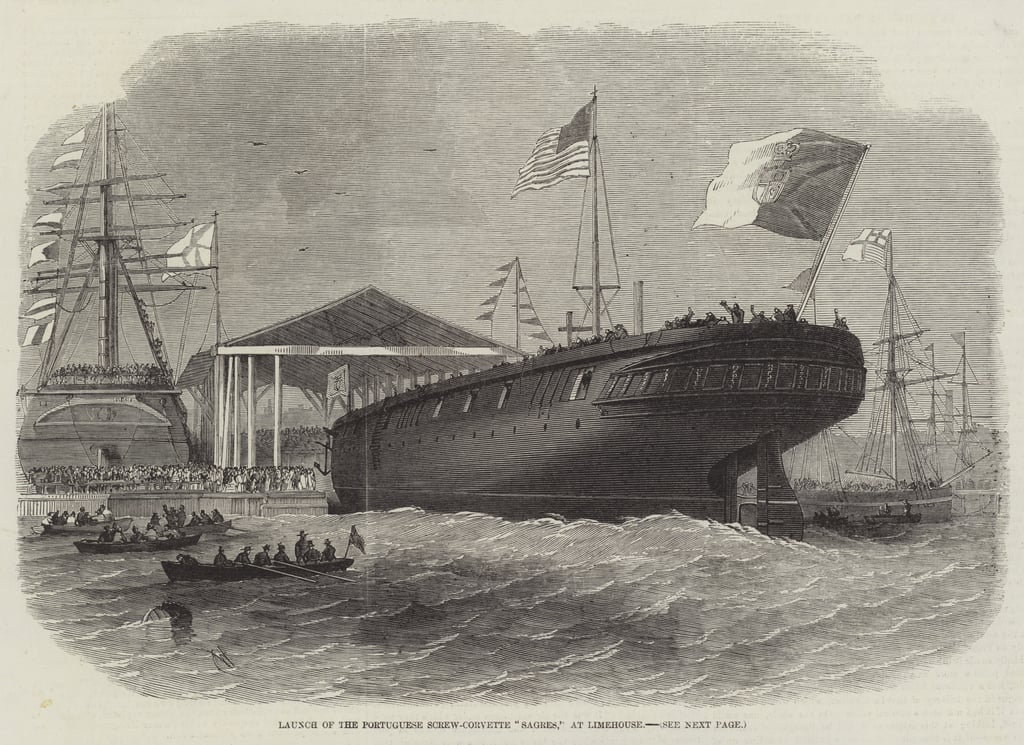
The launch of Sagres at Limehouse Yd, UK
This Portuguese naval three masts sailing wooden ship SAGRES measured 79m, displaced 1.382 tons, and was ordered and launched in 1858 by Young, Son & Magnay, Limehouse in UK. She had a low pressure steam engine rated for 300hp, capable of 12 knots. Together with the corvette BARTOLOMEU DIAS, she formed part of a fleet under the command of Prince D. Luis, later King of Portugal. From 1882 to 1898, after her engine moved out, she was moored at Douro river, Massarelos, Oporto, as a fixed school training ship for Navy sailors; 07/09/1898 she was laid up, sometime after she was dismantled. She was replaced by the ESTEPHANIA. No more info found so far.
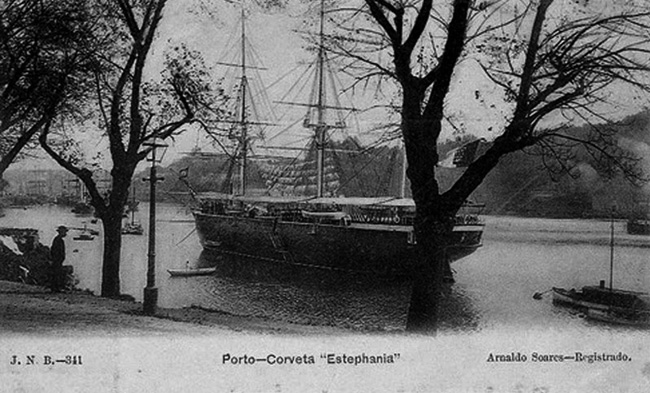

The steam frigate Estephania.
Assigned to the Portuguese naval school. She was a wooden barquentine-rigged (2.368 tons) launched as a steam corvette on 15/08/1859 by R. & H. Green, Blackwall. In 1898 she replaced SAGRES on Douro, and she was based in Massarelos, Oporto, in North Portugal.
 Portuguese Screw Sloops
Portuguese Screw Sloops
Afonso d’Albuquerque: She was built in Thames Iron Works, Blackwall, launched 9.7.1884 and completed in 1884. Wooden-built, fully rigged. Displacement was 1,092 tons, she measured 62.0 x 10.1 x 3.74m, had a single shaft, 1,360 hp, 13 kts, she carried 160 tons of coal and was armed with two 152mm/26 (6 in) and five 127mm/25 (5 in) BL Mk I/II/III/IV/V, and two 47/40 mm (3-pdr). Crew 178.
Duque da Terceira: Built in Arsenal de Marinha de Lisboa, launched 8.4.1864 and completed 1864. Displacement: 1,406 tons, 54.9 x 10.4 x 4.50m, 1 shaft 660 shp, 10 kts, coal 200 tons, 13 guns, crew 194. In the 1870s her armament was modernized, with eight 163mm/14 Armstrong 70pdr MLR. In the 1880s, two 149mm/22 RK L/25 C/75, and two 65mm/40 QF Hotchkiss anti-torpedo boats. Last upgrade, in the 1890s she had two 149mm/22 and two 120mm/44 and she was discarded in 1911.
 Portuguese Side-wheel steamers
Portuguese Side-wheel steamers
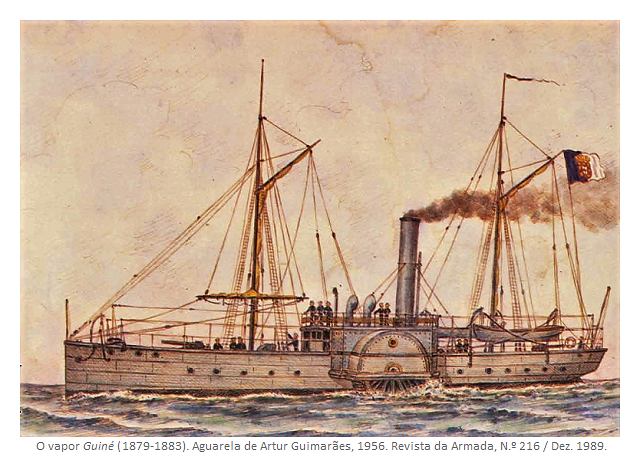
Guine, riverine gunboat of 1878. One of many that steamed African rivers before WWI
The subject matter is quite touchy. Four identified by Conways, no name or precise infos found, apart Guine.
The “Nova Marinha”
 Coastal Battleship Vasco da Gama (1875)
Coastal Battleship Vasco da Gama (1875)

British-built Casemate ironclad reconstructed, from thtee-masted to two-masted barquentine rigged. Her original 260mm guns were completed by a rear 150mm gun on a pivot traversible aft.
The subject has been treated in detail here.
 Portuguese Torpedo Boats
Portuguese Torpedo Boats
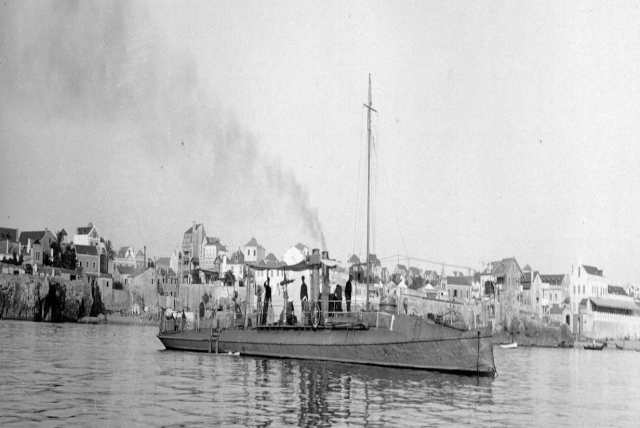
The Torpedo Boat Espadarte (1881)
Espadarte (1880): Displacement 54 t; Length 36 m, width 3.6 m, Draft 1 m, Propulsion 1 boiler 700 hp, 1 propeller, Speed 19 knots, armed with 2 machine gun, 2 torpedo tubes, Crew 20
N°2-4: Displacement 66 t, Length 36 m, Width 3.6 m, Draft 1 m, Propulsion 1 Boiler 700 hp, 1 propeller, Speed 19 knots, 2 machine guns, 2 torpedo tubes, Crew 22
 Portuguese Gunboats
Portuguese Gunboats
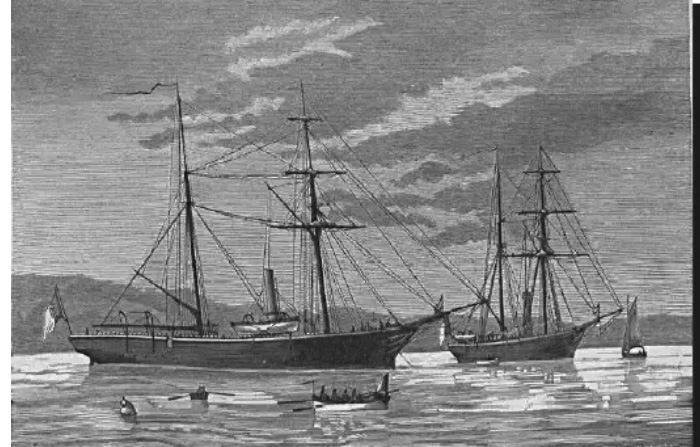
Gunboats Mondavi and Bengo

Gunboat Rio Ave

Gunboat Tejo
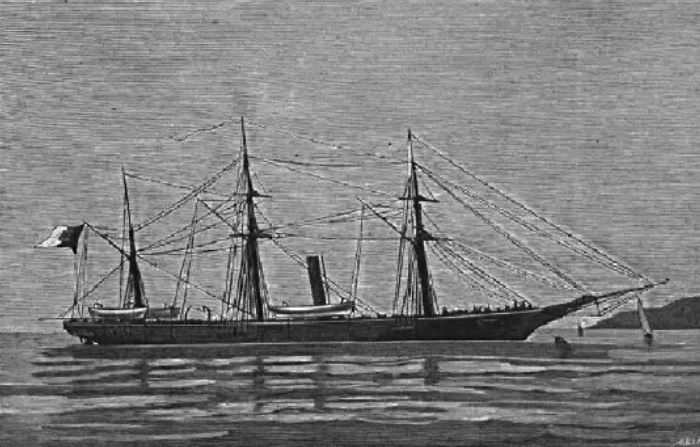
Gunboat Rio Vouga

Gunboat Zambeze
Tavira class (Tavira, Faro) (1878): discarded 1911 and 1912. Small 160 tons colonial gunboats.
Rio Lima class (Rio Lima, Sado, Tamega built 1875 UK, 48.8 x 9 m, 500 hp 16 kph.
Tejo class: Tajo, Douro, Quanza (1869-76-77) Built in Lisbon Arsenal, 47 x 8 m, 15 cm guns, 550 h VTE 16 kph/10 kts.
Rio Tâmega class (1879): Rio Tamega, Rio Sado): Built in Laird, Birkenhead in 1875 (discarded 1909 and 1921). Displacement 635 tons, composite construction 45.4 x 8.62 x 3.20m, 1 shaft 500 hp, 11 kts, coal 90 tons.Armed with a single 178mm/16 Armstrong MLR and four 121mm/14 Armstrong 40pdr MLR, crew 109.
Mandovi class (Mandovi, Bengo 1879-80). Laid Bros, Birkenhead. 38.1 x 7.3m (125 x 24ft) VTE 420 hp, 15.3 kph/9.5 kts, 6x 150 mm, 2x 50cm TTs with 20 torpedoes
Rio Ave 1880-82, Arsenal of Lisbon, 36.57 x 6.5 m (119 x 21 feets), reused Guadiana engine, 12.8 kph (8 knots)
Zaire class (1885): Zaire, Liberal. Buiilt Laird UK, 52.6 x 7m (140 x 23 ft)
Rio Vouga (1882): At Lisboa Arsenal, modified 1885, 49 x 8m (160 x 26 ft), VTE 600 hp, 14.4 kph (9 knots), 4 guns. She was discarded in 1909.
Vilhena (1882): Built at Arsenal da Marinha in Lisbon (discarded in 1916). Displacement 160 tons, dimensions 29.0 x 4.90 x 1.80, 2 shafts 310 hp, 12 kts, 30 tons coal, armed with a single 3-in 76mm/16. Crew 42.
Rio Vouga (1882): Built in Arsenal da Marinha Lisbon,launched 5.1.1882 (discarded 1909). Displacement 710/721 tons, 49.1 x 8.41 x 3.61m, 1 shaft VTE 600 hp, 10 kts, 100 tons coal, armed with a single 152mm/26 Armstrong gun, four 100mm/27 guns, crew 121.
Massabi class (Massabi, Cacongo), Yard unknown, launched 1884 (discarded 1908, both). Displacement 280 tons, 37 x 5.90 x 2m, 1 shaft 375 hp, 11 kts, 60 tons coal, single 3-in (76mm/16), crew 42.
Zambeze (1886): Lisboa Arsenal, 400 hp, 14 kph (9 knots) 3 guns
Diu (1889): Same, 45 x 8m, 500 hp, 8 knots.
It seems also the Portuguese Navy was shown the Nordenfelt submersible, but no purchase was made. It was allegedly tested by Sr. João Fontes Pereira de Mello, which submitted a 20 m x 5 m design with four drop-collar torpedoes of the Nordenfelt or Whitehad type in 1885.


 Latest Facebook Entry -
Latest Facebook Entry -  X(Tweeter) Naval Encyclopedia's deck archive
X(Tweeter) Naval Encyclopedia's deck archive Instagram (@navalencyc)
Instagram (@navalencyc)





 French Navy
French Navy Royal Navy
Royal Navy Russian Navy
Russian Navy Armada Espanola
Armada Espanola Austrian Navy
Austrian Navy K.u.K. Kriegsmarine
K.u.K. Kriegsmarine Dansk Marine
Dansk Marine Nautiko Hellenon
Nautiko Hellenon Koninklije Marine 1870
Koninklije Marine 1870 Marinha do Brasil
Marinha do Brasil Osmanlı Donanması
Osmanlı Donanması Marina Do Peru
Marina Do Peru Marinha do Portugal
Marinha do Portugal Regia Marina 1870
Regia Marina 1870 Nihhon Kaigun 1870
Nihhon Kaigun 1870 Preußische Marine 1870
Preußische Marine 1870 Russkiy Flot 1870
Russkiy Flot 1870 Svenska marinen
Svenska marinen Søværnet
Søværnet Union Navy
Union Navy Confederate Navy
Confederate Navy Armada de Argentina
Armada de Argentina Imperial Chinese Navy
Imperial Chinese Navy Marinha do Portugal
Marinha do Portugal Mexico
Mexico Kaiserliche Marine
Kaiserliche Marine 1898 US Navy
1898 US Navy Sovietskiy Flot
Sovietskiy Flot Royal Canadian Navy
Royal Canadian Navy Royal Australian Navy
Royal Australian Navy RNZN Fleet
RNZN Fleet Chinese Navy 1937
Chinese Navy 1937 Kriegsmarine
Kriegsmarine Chilean Navy
Chilean Navy Danish Navy
Danish Navy Finnish Navy
Finnish Navy Hellenic Navy
Hellenic Navy Polish Navy
Polish Navy Romanian Navy
Romanian Navy Turkish Navy
Turkish Navy Royal Yugoslav Navy
Royal Yugoslav Navy Royal Thai Navy
Royal Thai Navy Minor Navies
Minor Navies Albania
Albania Austria
Austria Belgium
Belgium Columbia
Columbia Costa Rica
Costa Rica Cuba
Cuba Czechoslovakia
Czechoslovakia Dominican Republic
Dominican Republic Haiti
Haiti Hungary
Hungary Honduras
Honduras Estonia
Estonia Iceland
Iceland Eire
Eire Equador
Equador Iran
Iran Iraq
Iraq Latvia
Latvia Liberia
Liberia Lithuania
Lithuania Mandchukuo
Mandchukuo Morocco
Morocco Nicaragua
Nicaragua Persia
Persia San Salvador
San Salvador Sarawak
Sarawak Uruguay
Uruguay Venezuela
Venezuela Zanzibar
Zanzibar Warsaw Pact Navies
Warsaw Pact Navies Bulgaria
Bulgaria Hungary
Hungary

 Bundesmarine
Bundesmarine Dutch Navy
Dutch Navy Hellenic Navy
Hellenic Navy Marina Militare
Marina Militare Yugoslav Navy
Yugoslav Navy Chinese Navy
Chinese Navy Indian Navy
Indian Navy Indonesian Navy
Indonesian Navy JMSDF
JMSDF North Korean Navy
North Korean Navy Pakistani Navy
Pakistani Navy Philippines Navy
Philippines Navy ROKN
ROKN Rep. of Singapore Navy
Rep. of Singapore Navy Taiwanese Navy
Taiwanese Navy IDF Navy
IDF Navy Saudi Navy
Saudi Navy Royal New Zealand Navy
Royal New Zealand Navy Egyptian Navy
Egyptian Navy South African Navy
South African Navy






























 Ukrainian Navy
Ukrainian Navy dbodesign
dbodesign